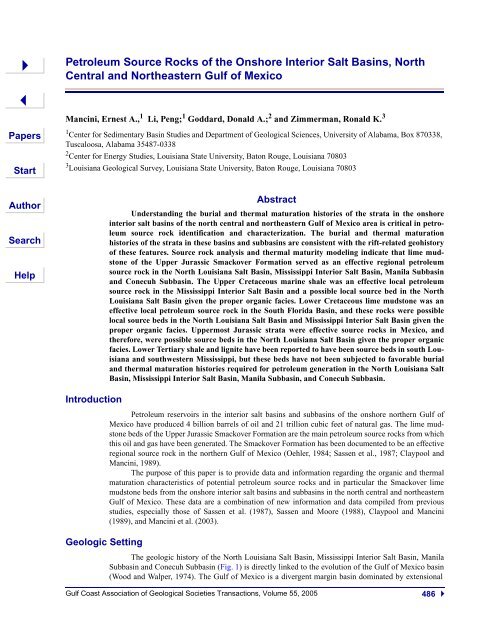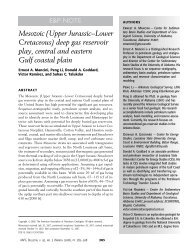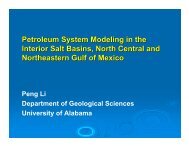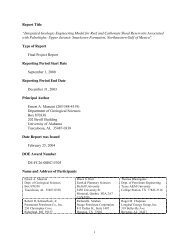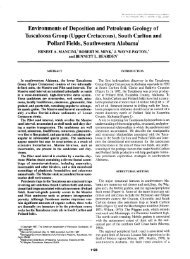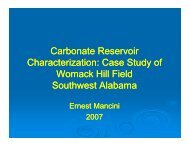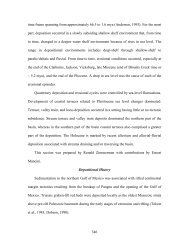Petroleum Source Rocks of the Onshore Interior Salt Basins, North ...
Petroleum Source Rocks of the Onshore Interior Salt Basins, North ...
Petroleum Source Rocks of the Onshore Interior Salt Basins, North ...
You also want an ePaper? Increase the reach of your titles
YUMPU automatically turns print PDFs into web optimized ePapers that Google loves.
<strong>Petroleum</strong> <strong>Source</strong> <strong>Rocks</strong> <strong>of</strong> <strong>the</strong> <strong>Onshore</strong> <strong>Interior</strong> <strong>Salt</strong> <strong>Basins</strong>, <strong>North</strong>Central and Nor<strong>the</strong>astern Gulf <strong>of</strong> MexicoMancini, Ernest A., 1 Li, Peng; 1 Goddard, Donald A.; 2 and Zimmerman, Ronald K. 31 Center for Sedimentary Basin Studies and Department <strong>of</strong> Geological Sciences, University <strong>of</strong> Alabama, Box 870338,Tuscaloosa, Alabama 35487-03382 Center for Energy Studies, Louisiana State University, Baton Rouge, Louisiana 708033 Louisiana Geological Survey, Louisiana State University, Baton Rouge, Louisiana 70803IntroductionGeologic SettingAbstractUnderstanding <strong>the</strong> burial and <strong>the</strong>rmal maturation histories <strong>of</strong> <strong>the</strong> strata in <strong>the</strong> onshoreinterior salt basins <strong>of</strong> <strong>the</strong> north central and nor<strong>the</strong>astern Gulf <strong>of</strong> Mexico area is critical in petroleumsource rock identification and characterization. The burial and <strong>the</strong>rmal maturationhistories <strong>of</strong> <strong>the</strong> strata in <strong>the</strong>se basins and subbasins are consistent with <strong>the</strong> rift-related geohistory<strong>of</strong> <strong>the</strong>se features. <strong>Source</strong> rock analysis and <strong>the</strong>rmal maturity modeling indicate that lime mudstone<strong>of</strong> <strong>the</strong> Upper Jurassic Smackover Formation served as an effective regional petroleumsource rock in <strong>the</strong> <strong>North</strong> Louisiana <strong>Salt</strong> Basin, Mississippi <strong>Interior</strong> <strong>Salt</strong> Basin, Manila Subbasinand Conecuh Subbasin. The Upper Cretaceous marine shale was an effective local petroleumsource rock in <strong>the</strong> Mississippi <strong>Interior</strong> <strong>Salt</strong> Basin and a possible local source bed in <strong>the</strong> <strong>North</strong>Louisiana <strong>Salt</strong> Basin given <strong>the</strong> proper organic facies. Lower Cretaceous lime mudstone was aneffective local petroleum source rock in <strong>the</strong> South Florida Basin, and <strong>the</strong>se rocks were possiblelocal source beds in <strong>the</strong> <strong>North</strong> Louisiana <strong>Salt</strong> Basin and Mississippi <strong>Interior</strong> <strong>Salt</strong> Basin given <strong>the</strong>proper organic facies. Uppermost Jurassic strata were effective source rocks in Mexico, and<strong>the</strong>refore, were possible source beds in <strong>the</strong> <strong>North</strong> Louisiana <strong>Salt</strong> Basin given <strong>the</strong> proper organicfacies. Lower Tertiary shale and lignite have been reported to have been source beds in south Louisianaand southwestern Mississippi, but <strong>the</strong>se beds have not been subjected to favorable burialand <strong>the</strong>rmal maturation histories required for petroleum generation in <strong>the</strong> <strong>North</strong> Louisiana <strong>Salt</strong>Basin, Mississippi <strong>Interior</strong> <strong>Salt</strong> Basin, Manila Subbasin, and Conecuh Subbasin.<strong>Petroleum</strong> reservoirs in <strong>the</strong> interior salt basins and subbasins <strong>of</strong> <strong>the</strong> onshore nor<strong>the</strong>rn Gulf <strong>of</strong>Mexico have produced 4 billion barrels <strong>of</strong> oil and 21 trillion cubic feet <strong>of</strong> natural gas. The lime mudstonebeds <strong>of</strong> <strong>the</strong> Upper Jurassic Smackover Formation are <strong>the</strong> main petroleum source rocks from whichthis oil and gas have been generated. The Smackover Formation has been documented to be an effectiveregional source rock in <strong>the</strong> nor<strong>the</strong>rn Gulf <strong>of</strong> Mexico (Oehler, 1984; Sassen et al., 1987; Claypool andMancini, 1989).The purpose <strong>of</strong> this paper is to provide data and information regarding <strong>the</strong> organic and <strong>the</strong>rmalmaturation characteristics <strong>of</strong> potential petroleum source rocks and in particular <strong>the</strong> Smackover limemudstone beds from <strong>the</strong> onshore interior salt basins and subbasins in <strong>the</strong> north central and nor<strong>the</strong>asternGulf <strong>of</strong> Mexico. These data are a combination <strong>of</strong> new information and data compiled from previousstudies, especially those <strong>of</strong> Sassen et al. (1987), Sassen and Moore (1988), Claypool and Mancini(1989), and Mancini et al. (2003).The geologic history <strong>of</strong> <strong>the</strong> <strong>North</strong> Louisiana <strong>Salt</strong> Basin, Mississippi <strong>Interior</strong> <strong>Salt</strong> Basin, ManilaSubbasin and Conecuh Subbasin (Fig. 1) is directly linked to <strong>the</strong> evolution <strong>of</strong> <strong>the</strong> Gulf <strong>of</strong> Mexico basin(Wood and Walper, 1974). The Gulf <strong>of</strong> Mexico is a divergent margin basin dominated by extensionalGulf Coast Association <strong>of</strong> Geological Societies Transactions, Volume 55, 2005486
Mancini et al.TexasEast Texas<strong>Salt</strong> BasinSabineUplift<strong>North</strong> Louisiana<strong>Salt</strong> BasinAA'LouisianaMississippiMonroeUpliftBB'AlabamaMississippi<strong>Interior</strong><strong>Salt</strong> BasinGeorgiaManila Sub-BasinC DConecuhRidgeD'C'ConecuhSub-BasinWigginsArchFloridaN400 km250 miFigure 1. Location map <strong>of</strong> interior salt basins and subbasins in <strong>the</strong> north central and nor<strong>the</strong>astern Gulf <strong>of</strong>Mexico area.tectonics and wrench faulting (Pilger, 1981; Miller, 1982; Klitgord et al., 1984; Van Siclen, 1984; Pindell,1985; Salvador, 1987; Winker and Buffler, 1988; Buffler, 1991). The origin <strong>of</strong> <strong>the</strong> Gulf <strong>of</strong> Mexicobasin consists <strong>of</strong> phases <strong>of</strong> crustal extension and thinning, <strong>of</strong> rifting and sea-floor spreading, and <strong>of</strong> <strong>the</strong>rmalsubsidence (Nunn, 1984).Sawyer et al. (1991) proposed <strong>the</strong> following as a model for <strong>the</strong> evolution <strong>of</strong> <strong>the</strong> Gulf <strong>of</strong> Mexicoand related onshore interior salt basins and subbasins based on <strong>the</strong> distribution <strong>of</strong> crust type. A Late Triassic-EarlyJurassic early rifting phase is typified by half-grabens bounded by listric normal faults andfilled with nonmarine red bed sediments and volcanics. A Middle Jurassic phase <strong>of</strong> rifting, crustal attenuationand <strong>the</strong> formation <strong>of</strong> transitional crust is characterized by a pattern <strong>of</strong> alternating basementpaleotopographic highs and lows and <strong>the</strong> accumulation <strong>of</strong> thick salt deposits. A Late Jurassic phase <strong>of</strong>sea-floor spreading and oceanic crust formation is typified by an extensive marine transgression as aresult <strong>of</strong> crustal cooling and subsidence. Subsidence continued into <strong>the</strong> Early Cretaceous and a carbonateshelf margin developed along <strong>the</strong> tectonic hinge zone <strong>of</strong> differential subsidence between thicktransitional crust and thin transitional crust.This depositional pattern was interrupted by a time <strong>of</strong> igneous activity and global sea-level fallduring <strong>the</strong> Late Cretaceous (mid-Cenomanian) that produced a major drop in sea level and resulted in<strong>the</strong> exposure <strong>of</strong> <strong>the</strong> shallow Cretaceous platform margin that rimmed <strong>the</strong> Gulf (Salvador, 1991). Thismid-Cenomanian unconformity is well developed in <strong>the</strong> nor<strong>the</strong>rn Gulf <strong>of</strong> Mexico area.The Mesozoic and Cenozoic sediments <strong>of</strong> <strong>the</strong> nor<strong>the</strong>rn Gulf <strong>of</strong> Mexico accumulated as a seaward-dippingwedge in differentially subsiding basins (Martin, 1978). Basement cooling andsubsidence resulted in an infilling <strong>of</strong> <strong>the</strong> accommodation space. Structural elements that affected <strong>the</strong>deposition <strong>of</strong> <strong>the</strong>se sediments included basement features associated with plate movement and featuresformed due to <strong>the</strong> movement <strong>of</strong> Jurassic salt. The graben system that developed is a result <strong>of</strong> rifting, andits geometry is a reflection <strong>of</strong> <strong>the</strong> direction <strong>of</strong> plate separation (MacRae and Watkins, 1996). The Lower487
<strong>Petroleum</strong> <strong>Source</strong> <strong>Rocks</strong> <strong>of</strong> <strong>the</strong> <strong>Onshore</strong> <strong>Interior</strong> <strong>Salt</strong> <strong>Basins</strong>, <strong>North</strong> Central and Nor<strong>the</strong>astern Gulf <strong>of</strong> MexicoCretaceous shelf margin corresponds to a major basement hinge. This feature dominated carbonate depositionthroughout <strong>the</strong> Early Cretaceous.The chief positive basement features that influenced <strong>the</strong> distribution and nature <strong>of</strong> Mesozoicdeposits are <strong>the</strong> Sabine Uplift, Monroe Uplift, Wiggins Arch, Choctaw Ridge, <strong>the</strong> Conecuh Ridge, <strong>the</strong>Pensacola Arch, and <strong>the</strong> Decatur Ridge. The Choctaw, Conecuh, Pensacola, and Decatur Ridge complexesare associated with <strong>the</strong> Appalachian fold and thrust structural trend that was formed in <strong>the</strong> latePaleozoic by tectonic events resulting from convergence <strong>of</strong> <strong>the</strong> <strong>North</strong> American and African-SouthAmerican continental plates. The Sabine Uplift, Monroe Uplift and Wiggins Arch are associated withcrustal extension and rifting (Miller, 1982; Sawyer et al., 1991). These features may be remnants <strong>of</strong> <strong>the</strong>rifted continental margin <strong>of</strong> <strong>North</strong> America. Paleotopography had a significant impact on <strong>the</strong> distribution<strong>of</strong> sediment, and positive areas within basins and along basin margins provided sources forMesozoic terrigenous sediments (Mancini et al., 1985). The <strong>North</strong> Louisiana <strong>Salt</strong> Basin and Mississippi<strong>Interior</strong> <strong>Salt</strong> Basin, which are major negative structural features are classified as <strong>the</strong> interior fractureportion <strong>of</strong> a margin sag basin using <strong>the</strong> classification <strong>of</strong> Kingston et al. (1983). These extensional basinswere associated with early rifting linked with wrench faulting and were actively subsiding depocentersthroughout <strong>the</strong> Mesozoic and into <strong>the</strong> Cenozoic.Movement <strong>of</strong> <strong>the</strong> Jurassic Louann <strong>Salt</strong> has produced an array <strong>of</strong> structural features (Martin,1978). <strong>Salt</strong>-related structures include diapirs, articlines, and entensional fault and half graben systems.Structural features resulting from halokinesis include <strong>the</strong> regional peripheral fault trend and numeroussalt domes and anticlines. The regional peripheral fault trend consists <strong>of</strong> a series <strong>of</strong> en echelon extensionalfaults and half grabens that are associated with salt movement. Structural deformation related tosalt movement was initiated probably during <strong>the</strong> Late Jurassic (Dobson and Buffler, 1997).Sedimentation in <strong>the</strong> nor<strong>the</strong>rn Gulf <strong>of</strong> Mexico was associated with rifted continental margin tectonics.Syn-rift Triassic graben-fill red-beds <strong>of</strong> <strong>the</strong> Eagle Mills Formation (Fig. 2) were depositedlocally as <strong>the</strong> oldest Mesozoic strata above pre-rift Paleozoic basement during <strong>the</strong> early stages <strong>of</strong> extensionand rifting (Tolson et al., 1983; Dobson, 1990).The syn-rift Middle Jurassic Werner Formation and Louann <strong>Salt</strong> are evaporite deposits thatformed during <strong>the</strong> initial transgression <strong>of</strong> marine water into <strong>the</strong> Gulf <strong>of</strong> Mexico (Salvador, 1987). Basementstructure influenced <strong>the</strong> distribution and thickness <strong>of</strong> Louann <strong>Salt</strong>, resulting in thick salt in <strong>the</strong>interior salt basins, and salt being absent over basement paleohighs (Wilson, 1975; Cagle and Khan1983, Dobson, 1990; Dobson and Buffler, 1991). The updip limit <strong>of</strong> thick salt and <strong>the</strong> location <strong>of</strong> <strong>the</strong>extensional faults associated with <strong>the</strong> regional peripheral fault trend coincide with a basement hinge lineand occur in <strong>the</strong> nor<strong>the</strong>rn part <strong>of</strong> <strong>the</strong>se salt basins and subbasins (Mancini and Benson, 1980; Dobson,1990; Dobson and Buffler, 1991).The distribution <strong>of</strong> <strong>the</strong> Late Jurassic post-rift deposits <strong>of</strong> <strong>the</strong> Norphlet, Smackover, Haynesvilleand Cotton Valley have been affected by basement paleotopography (Mancini and Benson, 1980; Dobson,1990; Dobson and Buffler, 1991). The Norphlet Formation consists <strong>of</strong> alluvial fan and plain, fluvialand wadi, eolian sheet, dune and interdune and marine shoreface siliciclastic sediments (Mancini et al.,1985; Dobson, 1990). The Smackover Formation, which was deposited on a ramp surface during <strong>the</strong>major Jurassic marine transgression in <strong>the</strong> Gulf, includes intertidal to subtidal laminated and microbiallime mudstone, subtidal peloidal wackestone and packstone, subtidal microbial boundstone, and subtidalto intertidal peloidal, ooid, oncoidal packstone and grainstone interbedded with fenestral limemudstone (Mancini and Benson, 1980; Benson, 1988; Dobson, 1990). This transgression has beenattributed to emplacement <strong>of</strong> oceanic crust in <strong>the</strong> Gulf and <strong>the</strong> resulting <strong>the</strong>rmal subsidence due tocrustal cooling (Nunn, 1984; Winker and Buffler, 1988). The Haynesville Formation consists <strong>of</strong> subaqueousto subaerial anhydrite, shelf to shoreline limestone, shale, and sandstone and eolian, fluvial,and alluvial sandstone (Tolson et al., 1983, Mann, 1988; Mancini et al., 1997). The Cotton Valley Groupincludes fluvial-deltaic and delta destructive sandstone and shale (Moore, 1983; Tolson, et al., 1983;Dobson, 1990). Deposition <strong>of</strong> <strong>the</strong> Early Cretaceous Knowles Limestone has been interpreted as <strong>the</strong> precursorto <strong>the</strong> development <strong>of</strong> <strong>the</strong> Lower Cretaceous carbonate shelf margin (Dobson, 1990).488
Mancini et al.SystemSeriesStageGroupFormationMississippiAlabamaMemberOligoceneRupelianVicksburg(see text for formations)PriabonianJacksonYazoo Clay(see textfor members)PaleogeneEocenePaleoceneUpper CretaceousBartonianLutetianYpresianSelandianDanianMaastrichtianCampanianSantonianConiacianClaiborneWilcoxMidwaySelmaTuronianTuscaloosaCenomanianMoodys Branch FormationCockfield FormationCook Mountain FormationKosciusko Sand"lower Lisbon"Zilpha ShaleWinona Fm.Tallahatta Fm. Tallahatta Fm.WilcoxHatchetigbee FormationTuscahoma FormationNanafalia FormationNaheola Formation"Jackson Gas Rock" Porters Creek Clay(Cane River)undifferentiatedMidway undiff.(see text for formations)Eutaw FormationUpper Tuscaloosa FormationMarine ShaleLower Tuscaloosa FormationMoodys BranchGosport Sand"upper Lisbon""middle Lisbon"(see textfor members)Tombigbee SandCretaceousAlbianWashita-FredericksburgundifferentiatedDantzler FormationAndrew FormationPaluxy FormationLower CretaceousAptianBarremianHauterivianBerriasianTithonianCottonValleyMooringsport FormationFerry Lake AnhydriteRodessa FormationJames Limestone/Pine Island ShaleSligo Formation/Hosston FormationSchuler FormationDorcheatShongalooJurassicUpperJurassicMiddleJurassicKimmeridgianOxfordianCallovianBathonianBajocianHaynesville FormationSmackover FormationNorphlet FormationLouann <strong>Salt</strong>Buckner Anhydrite"Brown Dense"Pine Hill AnhydriteAalenianWerner AnhydriteTriassicLwr. JurassicHettangian?Rhaetian?Eagle Mills FormationFigure 2. Stratigraphy for <strong>the</strong> north central and nor<strong>the</strong>astern Gulf <strong>of</strong> Mexico area.489
<strong>Petroleum</strong> <strong>Source</strong> <strong>Rocks</strong> <strong>of</strong> <strong>the</strong> <strong>Onshore</strong> <strong>Interior</strong> <strong>Salt</strong> <strong>Basins</strong>, <strong>North</strong> Central and Nor<strong>the</strong>astern Gulf <strong>of</strong> MexicoThe Early Cretaceous in <strong>the</strong> nor<strong>the</strong>rn Gulf <strong>of</strong> Mexico consists <strong>of</strong> fluvial-deltaic to coastal silicilasticsedimentation updip and <strong>the</strong> development <strong>of</strong> a broad carbonate shelf with a low-relief margindowndip at <strong>the</strong> boundary between thick transitional crust and thin transitional crust (Eaves, 1976; Winkerand Buffler, 1988; McFarlan and Menes, 1991; Sawyer et al., 1991). The development <strong>of</strong> a carbonateshelf margin during <strong>the</strong> Early Cretaceous, which does not conform to <strong>the</strong> basement structure, is <strong>the</strong> result<strong>of</strong> a combination <strong>of</strong> a change in <strong>the</strong> slope <strong>of</strong> <strong>the</strong> basement that is marked by a crustal hinge zone andJurassic sediment depositional patterns (Dobson, 1990; Sawyer et al., 1991). The hinge zone has formedas a result <strong>of</strong> differential subsidence across <strong>the</strong> crustal boundary between thick transitional crust and thintransitional crust (Corso, 1987). Although Jurassic Norphlet, Smackover and Haynesville depositionalpatterns are greatly affected by basement paleotopography, sediments, such as <strong>the</strong> Lower CretaceousKnowles Limestone, reflect an infilling <strong>of</strong> <strong>the</strong> basement low areas and a general progradation <strong>of</strong> <strong>the</strong> rampmargin (Dobson, 1990). This progradation has been interpreted by Dobson (1990) to produce a changefrom a carbonate ramp to a rimmed platform margin. The hiatus between <strong>the</strong> Cotton Valley Group-Knowles Limestone and <strong>the</strong> Hosston Formation is represented by most <strong>of</strong> <strong>the</strong> Valanginian Stage. Thisunconformity and hiatus are recognized throughout <strong>the</strong> Gulf Coast (McFarlan and Menes, 1991).The Lower Cretaceous shelf margin was exposed during <strong>the</strong> early Late Cretaceous by a majorlowering <strong>of</strong> sea level. This sea-level fall has been attributed to a combination <strong>of</strong> igneous activity andglobal sea-level fall (Salvador, 1991). A Late Cretaceous marine transgression followed this regionalerosional event, and this transgression in combination with <strong>the</strong> Laramide orogeny affected depositionfrom <strong>the</strong> Late Cretaceous to <strong>the</strong> Cenozoic (Salvador, 1991). Throughout <strong>the</strong> Cenozoic, <strong>the</strong> western Gulfwas <strong>the</strong> site <strong>of</strong> significant fluvial, deltaic and coastline siliciclastic sediment influx, while <strong>the</strong> easternGulf experienced principally carbonate deposition (Salvador, 1991).Potential <strong>Petroleum</strong> <strong>Source</strong> <strong>Rocks</strong>Three active petroleum source rocks have been reported from <strong>the</strong> onshore north central andnor<strong>the</strong>astern Gulf <strong>of</strong> Mexico area. The Upper Jurassic (Oxfordian) Smackover lime mudstone beds havebeen described as serving as source rocks in <strong>the</strong> <strong>North</strong> Louisiana <strong>Salt</strong> Basin, <strong>the</strong> Mississippi <strong>Interior</strong> <strong>Salt</strong>Basin, and <strong>the</strong> Manila and Conecuh Subbasins (Oehler, 1984; Sassen et al., 1987; Sassen and Moore,1988; Claypool and Mancini, 1989; Mancini et al., 2003). The Upper Cretaceous (Cenomanian-Turonian)Tuscaloosa marine shale beds have been reported as serving as source rocks in Mississippi (Koonset al., 1974). The Lower Cretaceous (Albian) Sunniland lime mudstone beds have been described asserving as source rocks in south Florida (Palacas, 1978; Palacas et al., 1984). In addition, Sassen (1990)reported that lower Tertiary (Paleocene/Eocene) Midway, Wilcox, and Sparta shale beds are sourcerocks in sou<strong>the</strong>rn Louisiana and that Paleocene/Eocene Wilcox lignite beds may be a petroleum sourcein southwestern Mississippi. Upper Jurassic (Tithonian) shale and carbonate beds are source rocks inMexico (Mancini et al., 2001).From source rock and oil characterization studies and from burial and <strong>the</strong>rmal maturation historymodeling, Mancini and Claypool (1989), Mancini et al., (1999), and <strong>the</strong> results from this work, haveshown that <strong>the</strong> Paleocene/Eocene shale and lignite beds have not been subjected to favorable burial and<strong>the</strong>rmal maturation histories required for petroleum generation in <strong>the</strong> <strong>North</strong> Louisiana <strong>Salt</strong> Basin(Fig. 3), Mississippi <strong>Interior</strong> <strong>Salt</strong> Basin (Fig. 4), Manila Subbasin (Fig. 5), and Conecuh Subbasin(Fig. 6). The Upper Cretaceous Tuscaloosa marine shale beds were an effective local petroleum sourcerock in parts <strong>of</strong> <strong>the</strong> Mississippi <strong>Interior</strong> <strong>Salt</strong> Basin and a possible local source bed in <strong>the</strong> <strong>North</strong> Louisiana<strong>Salt</strong> Basin given <strong>the</strong> proper organic facies but not in <strong>the</strong> Manila and Conecuh Subbasins. Theuppermost Jurassic strata and <strong>the</strong> Lower Cretaceous lime mudstone and shale beds were possible localsource beds in parts <strong>of</strong> <strong>the</strong> <strong>North</strong> Louisiana <strong>Salt</strong> Basin and Mississippi <strong>Interior</strong> <strong>Salt</strong> Basin given <strong>the</strong>proper organic facies. These beds probably were not source beds in <strong>the</strong> Manila and Conecuh Subbasinsbecause <strong>the</strong> proper organic facies do not appear to be present.490
PaluxyMancini et al.A)SubseaDepth0-1500-3000A1702701875 1702701974 1702720557 1701320349 1701320054 1706920079 1706900047 1706900174 1706900475 1706920017 1706900541 1711500016 1711520029TuscaloosaWilcoxMidwayNavarro-TaylorAustinA'SubseaDepth0-1500-3000-4500-4500-6000Ferry LakeRodessaJamesPine Island-6000Washita-Fred.-7500SligoRuskMooringsport-7500-9000-10500GlenRoseUndiff.-9000-10500-12000Cotton Valley-12000-13500-13500B)AA'SubseaSubseaDepthDepth1702701875 1702701974 1702720557 1701320349 1701320054 1706920079 1706900047 1706900174 1706900475 1706920017 1706900541 1711500016 1711520029-1500 -1500-2500 -25003000300030003000300030003000300030003000300030003000-3500 -3500EM-4500 -45004000400040004000400050005000500050005000500050005000500050005000500050006000600060006000600070007000700070007000700070007000700070007000700070008000800080008000800040004000400040004000400040004000-5500 MM-550060006000600060006000600060006000-6500 -6500-7500 -7500LM-8500 -8500800080008000800080008000800080009000900090009000900090009000900090009000900090002000-9500 -9500MG-10500 -105001000010000100001100011000110001000010000100001000010000100001100011000110001100011000-11500 -11500120001200012000120001200012000-12500 -125001300013000-13500 -13500-14500 -14500-15500-16500EM = Early MatureMM = Mid MatureLM = Late MatureMG = Main Gas Generation-15500-16500-17500 -17500Figure 3. Regional cross section and <strong>the</strong>rmal maturity pr<strong>of</strong>ile (A-A´) for <strong>the</strong> <strong>North</strong> Louisiana <strong>Salt</strong>Basin: A. Regional cross section and B. Thermal maturity pr<strong>of</strong>ile at present. See Figure 1 forlocation <strong>of</strong> cross section.491
)(<strong>Petroleum</strong> <strong>Source</strong> <strong>Rocks</strong> <strong>of</strong> <strong>the</strong> <strong>Onshore</strong> <strong>Interior</strong> <strong>Salt</strong> <strong>Basins</strong>, <strong>North</strong> Central and Nor<strong>the</strong>astern Gulf <strong>of</strong> MexicoA)BLogLogDepthDepth2308320011 2305120020 2305120036 2316300049 2316320150 2308920043 2304920005 2304920004 23049200320 0VicksburgJacksonMoody's BranchB'Cook Mountain2000 Sparta2000Cane River2000(-1871)2000(-1673)2000(-1736)2000(-1790)2000(-1629)2000(-1802)2000(-1721)2000(-1731)2000(-1700)4000 4000MidwayWilcox4000(-3871)4000(-3673)4000(-3736)4000(-3790)4000(-3629)4000(-3802)4000(-3721)4000(-3731)4000(-3700)Gas Rock6000 Selma60006000(-5871)6000(-5673)Marine ShaleTuscaloosaLower TuscaloosaLower Cretaceous8000 Paluxy80008000(-7673)6000(-5736)8000(-7736)6000(-5790)8000(-7790)6000(-5629)8000(-7629)Eutaw6000(-5802)8000(-7802)6000(-5721)8000(-7721)6000(-5731)8000(-7731)6000(-5700)8000(-7700)10000 1000010000(-9736)10000(-9790)10000(-9629)10000(-9802)10000(-9721)10000(-9731)10000(-9700)12000 Sligo/Hosston1200012000(-11790)12000(-11629)MooringsportFerry LakeRodessa14000 Pine Island 1400014000(-13629)12000(-11802)14000(-13802)12000(-11721)14000(-13721)12000(-11731)14000(-13731)12000(-11700)14000(-13700)Cotton Valley16000 1600016000(-15629)16000(-15802)16000(-15721)16000(-15731)16000(-15700)18000 1800018000(-17802)18000(-17721)18000(-17731)18000(-17700)Haynesville20000 20000NorphletSmackover20000(-19731)20000(-19700)Louann <strong>Salt</strong>22000 2200022000(-21731)22000(-21700)24000 2400024000(-23700)B)26000 26000BSubseaSubsea2308320011 2305120020 2305120036 2316300049 2316320150 2308920043 2304920005 2304920004 2304920032DepthDepth-4000 -4000B'500050005000500050005000500050005000-5000 -5000600060006000600060006000600060006000-6000 -600070007000700070007000-7000 EM-7000700070007000700080008000800080008000800080008000-8000 -80009000900090009000100001000010000900010000900090009000-9000 -9000MM100001000010000-10000 -1000011000110001100011000110001100011000-11000 -11000120001200012000120001200012000-12000 -12000130001300013000130001400014000140001300013000-13000 -13000LM1400014000-14000 -140001500015000150001500015000-15000 -15000-16000EM = Early MatureMG-16000MM = Mid Mature-17000 LM = Late Mature-17000MG = Main Gas Generation-18000 -18000Figure 4. Regional cross section and <strong>the</strong>rmal maturity pr<strong>of</strong>ile (B-B´) for <strong>the</strong> Mississippi <strong>Interior</strong><strong>Salt</strong> Basin: A. Regional cross section and B. Thermal maturity pr<strong>of</strong>ile at present. See Figure 1 forlocation <strong>of</strong> cross section.16000160001700018000160001700018000160001700018000160001700018000492
(9 09 09 09 09 075 075 075 075 075 06 06 06 06 06 045 045 045 045 045 03 03 03 03 03 015 015 015 015 015 0Mancini et al.A)CSubseaSubseaDepthDepth102520042 102520112 100320009 100320020 1003200260 0C'-1500 -1500(-13 9)(-1293)(-1454)(-1308)(-1403)-3000 -3000(-28 9)(-2793)(-2954)(-2808)(-2903)-4500 Selma-4500(-43 9)EutawTuscaloosa-6000 -6000(-58 9)(-4293)(-5793)Lower Tuscaloosa(- 454)(-5954)(-4308)(-5808)(- 403)(-5903)Marine Shale-7500 Lower Cretaceous-7500(-73 9)(-7293)(-7454)(-7308)(-7403)-9000 -9000(- 8 9)(-8793)(-8954)(- 808)(-8903)105 0(-10293)-10500 Paluxy-10500105 0(-10454)Rodessa Pine Island105 0(-10308)Mooringsport105 0(-10403)12 0(- 1793)-12000 -12000Sligo/Hosston12 0(- 1954)12 0(- 1808)Ferry Lake12 0(- 1903)135 0(-13293)-13500 -13500135 0(-13454)135 0(-1 308)135 0(-13403)Cotton Valley-15000 -1500015 0(-14954)15 0(-14808)15 0(-14903)-16500 Haynesville-16500165 0(-16454)165 0(-16308)165 0(-16403)Upper Smackover Lower Smackover-18000 -1800018 0(-17808)Buckner18 0(-17903)-19500 -19500Norphlet195 0(-19403)-21000 -21000B)CSubsea 102520042 102520112 100320009 100320020 100320026 SubseaDepthDepth-6000 -6000C'700080007000-7000 -7000EM-8000 -8000800070008000700080007000800090009000-9000 -900090009000900010000-10000 -1000010000100001000011000-11000 -1100011000110001100012000-12000 MM-1200012000120001200013000-13000 -13000130001300013000-14000 -14000140001400014000-15000 -15000150001500015000-16000 -16000160001600016000-17000 -17000170001700017000-18000 -18000LM-19000 -19000-20000EM = Early MatureMM = Mid MatureLM = Late Mature-20000-21000 -21000Figure 5. Regional cross section and <strong>the</strong>rmal maturity pr<strong>of</strong>ile (C-C´) for <strong>the</strong> Manila Subbasin: A.Regional cross section and B. Thermal maturity pr<strong>of</strong>ile at present. See Figure 1 for location <strong>of</strong>cross section.18000180001900020000493
((<strong>Petroleum</strong> <strong>Source</strong> <strong>Rocks</strong> <strong>of</strong> <strong>the</strong> <strong>Onshore</strong> <strong>Interior</strong> <strong>Salt</strong> <strong>Basins</strong>, <strong>North</strong> Central and Nor<strong>the</strong>astern Gulf <strong>of</strong> MexicoA)DSubseaSubseaDepthDepth113120001 109920002 109920007 103520008 1053200070 0D'1500(-1407)1500(-1449)1500(-1225)1500(-1133)1500(-1194)-1500 -1500-3000 -3000Selma3000(-2907)-4500 EutawTuscaloosa-4500Ferry Lake4500(-4407)Marine ShaleLower Tuscaloosa-6000-7500Lower CretaceousPaluxyMooringsportRodessa-6000-7500Upper SmackoverLower SmackoverSligo/Hosston-9000 -90006000(-5907)7500(-7407)3000(-2949)4500(-4449)6000(-5949)7500(-7449)9000(-8949)3000(-2725)4500(-4225)6000(-5725)7500(-7225)9000(-8725)Pine Island3000(-2633)4500(-4133)6000(-5633)7500(-7133)9000(-8633)3000(-2694)4500(-4194)6000(-5694)7500(-7194)9000(-8694)Buckner-10500 -10500Cotton Valley10500(-10449)10500(-10225)10500(-10133)10500(-10194)12000(-11949)12000(-11725)12000(-11633)12000(-11694)-12000 -1200013500(-13449)NorphletHaynesville13500(-13133)13500(-13194)-13500 -13500-15000 -15000B)D113120001 109920002 109920007 103520008 105320007SubseaSubseaDepthDepth-6000 -6000D'-8000 EM-800080008000800080008000-10000 -1000010000100001000010000-12000 -12000MM12000120001200012000-14000 -140001400014000-16000 -16000EM = Early MatureMM = Mid MatureLMLM = Late Mature-18000 -18000Figure 6. Regional cross section and <strong>the</strong>rmal maturity pr<strong>of</strong>ile (D-D´) for <strong>the</strong> Conecuh Subbasin:A. Regional cross section and B. Thermal maturity pr<strong>of</strong>ile. See Figure 1 for location <strong>of</strong> cross section.494
<strong>Petroleum</strong> <strong>Source</strong> <strong>Rocks</strong> <strong>of</strong> <strong>the</strong> <strong>Onshore</strong> <strong>Interior</strong> <strong>Salt</strong> <strong>Basins</strong>, <strong>North</strong> Central and Nor<strong>the</strong>astern Gulf <strong>of</strong> MexicoTable 1. Organic geochemical analyses <strong>of</strong> core samples, <strong>North</strong> Louisiana <strong>Salt</strong> Basin.S am ple D epth TOC 2 T m a x3S1 4 S2 5 S3 6123456789101112N o . W e ll P a r is h (feet) U nit 1 (% ) (ºC ) (m g /g ) (m g /g ) (m g /g ) P I 7 PC 8 H I 9 O I 10 TAI 11 K e r o g e n 121 George Franklin #1 Richland 11,690.50 Sm k 0.16 334 0.06 0.08 0.35 0.43 0.00 50 218 3 Am2 George Franklin #1 Richland 11,770.00 Sm k 0.25 344 0.13 0.09 0.16 0.59 0.02 36 64 3 Am3 Colvin #2 Lincoln 10,856.00 Sm k 0.32 333 0.16 0.15 0.38 0.52 0.03 47 119 3 H4 M cGehee #1 Lincoln 13,439.00 Sm k 0.78 286 0.20 0.10 1.10 0.67 0.02 13 141 3+ Am /H5 M cGehee #1 Lincoln 13,602.00 Sm k 0.38 314 0.09 0.04 0.36 0.69 0.01 11 95 3+ Am /H6 Bearden #1 U nion 10,170.00 Sm k 0.14 288 0.11 0.04 0.16 0.73 0.01 29 114 3- H7 B-1 H am iter Bossier 10,568.00 Sm k 0.19 318 0.13 0.06 0.24 0.68 0.02 32 126 3- H8 W aller #1 Claiborne 10,390.00 Sm k 0.18 323 0.06 0.04 0.48 0.60 0.01 22 267 3- Am9 Sherm an #1 Claiborne 10,216.00 Sm k 0.24 430 0.20 0.14 0.18 0.59 0.03 58 75 3- Am /H10 D illon H eirs Caddo 7,015.00 CV 0.41 432 0.32 0.35 1.12 0.48 0.05 85 273 2 Am11 F. W appler Caddo 8,683.00 CV 0.75 370 0.17 0.58 0.54 0.23 0.06 77 72 2+ Am12 F. W appler Caddo 8,793.00 CV 0.62 336 0.09 0.05 0.72 0.64 0.01 8 116 2+ Am /H13 F. W appler Caddo 8,801.00 CV 1.80 441 0.30 2.71 0.42 0.10 0.25 151 23 2+ H14 F. W appler Caddo 9,351.00 CV 0.62 375 0.19 0.20 0.60 0.49 0.03 32 97 2+ H15 L. Enloe Claiborne 10,714.00 Sm k 0.19 308 0.21 0.10 0.94 0.68 0.03 53 495 3- H /W16 Bankston Franklin 14,656.00 CV 0.35 293 0.17 0.09 0.65 0.65 0.02 26 186 3 Am17 D avis Bros. Jackson 10,944.00 Boss 0.46 331 0.14 0.12 0.09 0.54 0.02 26 20 3- H18 D avis Bros. Jackson 12,956.00 Boss 0.43 304 0.10 0.08 0.22 0.56 0.01 19 51 3- H19 D avis Bros. Jackson 12,976.00 Boss 0.61 313 0.11 0.07 0.02 0.61 0.01 11 3 3- H20 C. Atkins N atchitoches 11,203.00 GR 0.10 288 0.09 0.03 0.36 0.75 0.01 30 360 3- Am21 H uffm an-M cN eely N atchitoches 17,480.00 CV 0.11 325 0.06 0.04 0.18 0.60 0.01 36 164 3+ Am22 J. Bentley Rapides 12,911.00 Sligo 0.23 365 0.10 0.10 0.23 0.50 0.02 43 100 3- Am /H23 J. Bentley Rapides 12,948.00 Sligo 0.45 408 0.00 0.07 0.35 0.00 0.01 16 78 3- Am /H24 Chicago M ill Tensas 14,876.00 H oss 1.69 519 0.04 0.09 0.16 0.31 0.01 5 9 3- H25 Chicago M ill Tensas 15,520.00 H oss 4.09 524 0.04 0.20 0.05 0.17 0.02 5 1 3- H26 Chicago M ill Tensas 15,560.00 H oss 0.51 333 0.06 0.06 0.07 0.50 0.01 12 14 3- H27 N . M anning U nion 16,016.00 p-salt 0.26 311 0.03 0.03 0.15 0.50 0.00 12 58 3 Am28 N . M anning U nion 16,057.00 p-salt 0.18 252 0.01 0.00 0.29 1.00 0.00 0 161 3+ Am29 N . M anning U nion 16,074.00 p-salt 0.13 252 0.01 0.00 0.12 1.00 0.00 0 92 3+ Am30 Frazier U nit W ebster 10,874.00 Sm k 0.24 318 0.18 0.13 0.59 0.58 0.03 54 246 3- H31 Frazier U nit W ebster 11,250.00 Sm k 0.21 411 0.06 0.10 0.24 0.38 0.01 48 114 3- H32 H . D avis W ebster 11,043.00 Sm k 0.28 380 0.02 0.03 0.15 0.40 0.00 11 54 3 Am /H33 H . D avis W ebster 11,243.00 Sm k 0.16 305 0.01 0.01 0.15 0.50 0.00 6 94 3 Am34 CZ 10-11 W inn 13,690.00 CV 0.57 276 0.03 0.03 0.22 0.50 0.00 5 39 3+ Am35 CZ 10-11 W inn 13,804.00 CV 0.47 252 0.03 0.01 0.21 0.75 0.00 2 45 3+ Am /H36 CZ 10-11 W inn 13,924.00 CV 0.48 252 0.01 0.01 0.02 0.50 0.00 2 4 3+ Am37 CZ 10-11 W inn 13,946.00 CV 0.30 354 0.03 0.05 0.13 0.38 0.01 17 43 3+ AM /I38 CZ 5-7 W inn 15,608.00 Boss 0.28 307 0.02 0.04 0.00 0.33 0.00 14 0 3+ I39 CZ 5-7 W inn 16,418.00 Boss 0.34 355 0.05 0.07 0.11 0.42 0.01 21 32 3+ I40 CZ 5-7 W inn 16,431.00 Boss 0.34 329 0.06 0.10 0.37 0.38 0.01 29 109 3+ W /I41 Pardee W inn 16,200.00 Boss 0.35 322 0.21 0.29 0.29 0.42 0.04 83 83 3+ Am /I42 Pardee W inn 16,400.00 Boss 0.35 328 0.19 0.16 0.16 0.54 0.03 46 46 3+ AM /IU n it: S m k = S m ack o v er, C V = C o tto n V alley, B o ss= B o ssier, G R = G len R o se, H o ss= H o ssto n , p -salt= p re-salt.TO C=total organic carbon.T m a x =tem perature index.S1=free hydrocarbon.S2=residual hydrocarbon potential.S3=CO 2 produced from kerogen pyrolysis.P I= S 1/ (S 1 + S 2 ).PC=0.083 (S1+S2).H I=hydrogen index.O I=oxygen index.T A I= th erm al alteratio n in d ex .K erogen: AM =am orphous, H =herbaceous, W =woody, I=inertinite.496
Mancini et al.Table 2. Organic geochemical analyses <strong>of</strong> core samples, Manila and Conecuh Subbasins.g g y pSatu-Trans- Temp Hydro- rate/ Pris-13 C13 CWell Car- Organic S1+S2 forma- Max Kero- TAI Bitu- car- HC/ Aro- tane/ Satu- Aro-Permit County/ Rock Depth bonate Carbon Yield tion Yield H gen 1-5 men bons org matic Phy- rate maticNo. Area 1 Unit 2 (feet) (%) (%) (mg/g) Ratio ( o C) Index Type 3 Scale (ppm) (ppm) C 4 Ratio tane CPI (%) (%)355 Esc Tus 5,814 2.30 1.18 1.11 0.05 416 89 Am(Al 2- 634 338 2.90 3.50 >1 >1 -26.40 -24.50427 Esc Tus 6,080 51.00 2.63 7.38 0.02 431 273 Am(Al 2- 1,440 630 2.10 1.90 >1 >1 -26.30 -25.302182 Cla Tus 5,271 15.60 2.75 7.75 0.01 415 277 Am(Al 2- 1,050 540 2.00 2.30 1 -26.20 -24.603299 Bal Hay 15,00 -- 0.05 -- -- -- -- -- -- -- -- -- -- -- -- -- --735 Cla Smk 11,15 85.10 0.29 0.28 0.46 425 51 Am(Al 2- 395 164 5.60 3.60 >1 1 -27.40 -24.301438 Cla Smk 10,98 99.00 0.11 0.08 0.12 426 63 Am(Al 2- 48 28 2.50 2.80 1 >1 -27.50 -26.803648 Cla Smk 13,48 59.20 0.28 0.27 0.19 433 78 Am(Al 2 235 164 5.90 3.30 >1 >1 -26.50 -24.601352 Mon Smk 9,221 -- 0.04 -- -- -- -- -- -- -- -- -- -- -- -- -- --1592 Mon Smk 14,24 75.00 0.54 0.47 0.17 433 72 Am 2+ 449 266 4.90 2.10 1 -24.00 24.904673 Mon Smk 14,59 94.20 0.05 0.03 0.50 -- 40 -- -- -- -- -- -- -- -- -- --1584 Bal Smk 16,22 -- 0.42 -- -- -- -- Am 2 -- -- -- -- -- -- -- --2075 Bal Smk 18,33 89.20 0.49 0.30 0.43 -- 34 Am 3- 327 322 6.60 16.10 1 1 -26.40 -25.902587 Bal Smk 19,86 95.80 0.20 0.04 0.25 -- 15 Am(Al 3+ 37 27 1.40 5.20
<strong>Petroleum</strong> <strong>Source</strong> <strong>Rocks</strong> <strong>of</strong> <strong>the</strong> <strong>Onshore</strong> <strong>Interior</strong> <strong>Salt</strong> <strong>Basins</strong>, <strong>North</strong> Central and Nor<strong>the</strong>astern Gulf <strong>of</strong> MexicoW ell Name County/State 1Table 3. Analyses y <strong>of</strong> potential p Smackover source rocks, , Mississippi <strong>Interior</strong> <strong>Salt</strong> Basin.(feet) (w t% ) Kerogen 2 3%R o T max (°C) 4 HI 5Depth TOCWeissinger Lumber Issaquena + 8,451 0.36 Am/Al 2 430 66Flora Johnson #1 Newton + 11,775 0.26 Am/Al 0.55 431 134Masonite 25-14 Clarke + 14,586 0.24 Am/Al 0.9 429 91USA Rubie Bell #1 Scott + 14,902 0.48 Am/Al 0.9 431 137Bishop-Cooley #1 Wayne + 15,541 1.35 Am/Al 1.5 427 27R. M. Thomas #1 Smith + 16,554 0.27 Am/Al 1.5 432 62Grief Bros. #1 Jasper + 17,015 0.44 Am/Al 0.55 433 54McFarland #1 Jones + 19,865 0.28 Am/Al 1.5 410 25Crain et al. 1-4 Rankin + 20,179 0.24 Am/Al 2 420 50Crown Zellerbach #1 Simpson + 23,981 4.55 Am/Al 2 367 23Jackson #1 Choctaw ++ 10,532 0.3 Am/Al 0.45 -- --Bolinger 3-4 Choctaw ++ 10,610 0.07 Am/Al 0.45 -- 42Stewart 6-5 Choctaw ++ 12,245 0.24 Am/Al 0.45 -- 22Britton #1 Washington ++ 16,101 0.08 Am/Al 1.5 -- 12Chatom 2-01 Washington ++ 16,167 0.19 Am/Al 1.5 -- 10Foster 10-6 Washington ++ 19,359 0.25 Am/Al 1.5 -- 41 State: + M ississippi, ++ Alabama.2 Kerogen: Am=Amorphous, Al=Algal (microbial).3 %R o : Vitrinite reflectance (% R o ) was determined by converting TAI values to R o values using <strong>the</strong>conversion chart <strong>of</strong>Geochem Laboratories.4 T max : temperature index.5 HI: hydrog en index.Conclusions1. The Upper Jurassic Smackover lime mudstone beds served as an effective regional petroleumsource rock in <strong>the</strong> north central and nor<strong>the</strong>astern Gulf <strong>of</strong> Mexico area.2. The Upper Cretaceous Tuscaloosa marine shale was an effective local petroleum source rock in<strong>the</strong> Mississippi <strong>Interior</strong> <strong>Salt</strong> Basin and a possible local source bed in <strong>the</strong> <strong>North</strong> Louisiana <strong>Salt</strong>Basin given <strong>the</strong> proper organic facies.3. The uppermost Jurassic and Lower Cretaceous shale and lime mudstone beds were possiblepetroleum source rocks in <strong>the</strong> <strong>North</strong> Louisiana <strong>Salt</strong> Basin and <strong>the</strong> Mississippi <strong>Interior</strong> <strong>Salt</strong> Basingiven <strong>the</strong> proper organic facies.AcknowledgmentsThe burial and <strong>the</strong>rmal maturation history modeling for this project was accomplished using BasinMod® 1D s<strong>of</strong>tware application <strong>of</strong> Platte River Associates, Inc. This research was funded by <strong>the</strong> U.S.Department <strong>of</strong> Energy, Office <strong>of</strong> Fossil Energy through <strong>the</strong> National Energy Technology Laboratory.However, any opinions, findings, conclusions or recommendations expressed herein are those <strong>of</strong> <strong>the</strong>authors and do not necessarily reflect <strong>the</strong> views <strong>of</strong> <strong>the</strong> U.S. Department <strong>of</strong> Energy.498
Mancini et al.Table 4. Analyses <strong>of</strong> Smackover crude oil samples, Mississippi <strong>Interior</strong> <strong>Salt</strong> Basin.y p , ppField County Depth ?API Sulfur 3 C 15+ HC 4 C 15+ C 15+ C 15+ C 15+ NSO Saturate/ Pristane/ CPI13 C13 C(ft) gravity (%) (%) asphaltene 5 saturate 5 aromatic 5 comp. 5 aromatic phytane sulfate aromatic(%) (%) (%) (‰) (‰)Pachuta Creek 1 Clarke + 13,065 37.6 -- 73.4 4.9 49.8 39.7 5.6 1.25
Depth Subsurface (feet)Depth Subsurface (feet)02000400060008000100001200014000020004000600080001000012000A) API 1702701974JK200 150 100 50 0Age (my)Age (my)C) API 0102520112JK14000200 150 100 50 0Age (my)PalPalNNFmt= 0Fmt = 0UndiffNavarroTaylorAustinEagel FordTuscaloosaMooringsportFerry LakeRodessaJamesPine IslandSligo/HosstonCotton ValleySmackoverNorphletUndiffSelmaEutawTuscaloosaMarine TuscaloosaL. TuscaloosaL. CretaceousPaluxyMooringsportFerry LakeRodessaPine IslandSligo/HosstonCotton ValleyHaynesvilleBucknerU. SmackoverL. SmackoverNorphletFigure 7. Burial history pr<strong>of</strong>iles for wells: A. API Number 1702701974, <strong>North</strong> Louisiana <strong>Salt</strong> Basin, B. API Number 2304920032, Mississippi <strong>Interior</strong><strong>Salt</strong> Basin, C. API Number 0102520112, Manila Subbasin, and D. API Number 0105320007, Conecuh Subbasin. See Figures 3 to 6 for location <strong>of</strong> wells.Depth Subsurface (feet)Depth Subsurface (feet)01000020000300000500010000B) API 2304920032J K Pal N200 150 100 50 0D) API 0105320007AgeAge(my)(my)J K Pal N1500016000200 150 100 50 0Age (my) Age (my)FmUndiffVicksburgJacksonMoody's BranchCook MountainSpartaCane Rivert = 0Fmt = 0WilcoxMidwaySelmaEutawTuscaloosaMarine ShaleMassive SandPaulxyMooringsportFerry LakeRodessaPine IslandSligo/HosstonCotton ValleyHaynesvilleSmackoverNorphletLouann <strong>Salt</strong>UndiffSelmaEutawTuscaloosaMarine TuscaloosaL. TuscaloosaL. CretaceousPaluxyMooringsportRodessaPine IslandSligo/HosstonCotton ValleyHaynesvilleBuckerU. Smackover/L. SmackoverNorphlet<strong>Petroleum</strong> <strong>Source</strong> <strong>Rocks</strong> <strong>of</strong> <strong>the</strong> <strong>Onshore</strong> <strong>Interior</strong> <strong>Salt</strong> <strong>Basins</strong>, <strong>North</strong> Central and Nor<strong>the</strong>astern Gulf <strong>of</strong> Mexico500
Cumulative Hydrocarbon / TOC (mg/g TOC)Cumulative Hydrocarbon / TOC (mg/g TOC)5004003002001002502001501005002000200A) API 1702701974JJ150150K100Age (my)K100Age (my)5050PalPalNNHQ0HQ0in-situOilin-situGasin-situResidueexpelledOilexpelledGasin-situOilin-situGasin-situResidueexpelledOilexpelledGasFigure 9. Hydrocarbon expulsion plots for wells: A. API Number 1702701974, <strong>North</strong> Louisiana <strong>Salt</strong> Basin, B. API Number 23-049-20032, Mississippi<strong>Interior</strong> <strong>Salt</strong> Basin, C. API Number 0102520112, Manila Subbasin, and D. API Number 0105320007, Conecuh Subbasin. See Figures 3 to 6 for location <strong>of</strong>wells.Cumulative Hydrocarbon / TOC (mg/g TOC)Cumulative Hydrocarbon / TOC (mg/g TOC)50040030020010020015010050B) API 2304920032C) API 0102520112 D) API 010532000702000200JJ150150K100Age (my)K100Age (my)5050PalPalNNHQ0HQ0in-situOilin-situGasin-situResidueexpelledOilexpelledGasin-situOilin-situGasin-situResidueexpelledOilexpelledGas<strong>Petroleum</strong> <strong>Source</strong> <strong>Rocks</strong> <strong>of</strong> <strong>the</strong> <strong>Onshore</strong> <strong>Interior</strong> <strong>Salt</strong> <strong>Basins</strong>, <strong>North</strong> Central and Nor<strong>the</strong>astern Gulf <strong>of</strong> Mexico502
Mancini et al.References CitedBuffler, R.T., 1991, Early evolution <strong>of</strong> <strong>the</strong> Gulf <strong>of</strong> Mexico basin, in D. Goldthwaite, ed. An Introduction to CentralGulf Coast Geology: New Orleans, New Orleans Geological Society, p. 1-15.Cagle, J.W., and M.A. Khan, 1983, Smackover-Norphlet stratigraphy, South Wiggins Arch, Mississippi and Alabama:Gulf Coast Association <strong>of</strong> Geological Societies Transactions, v. 33, p. 23-29.Claypool, G.E., and E.A. Mancini, 1989, Geochemical relationships <strong>of</strong> petroleum in Mesozoic reservoirs to carbonatesource rocks <strong>of</strong> Jurassic Smackover Formation, southwestern Alabama, American Association <strong>of</strong> <strong>Petroleum</strong>Geologists Bulletin, v. 73, p. 904-924.Corso, W., 1987, Development <strong>of</strong> <strong>the</strong> Early Cretaceous northwest Florida carbonate platform [unpublished Ph.D.dissertation]: The University <strong>of</strong> Texas, 136 p.Dobson, L.M., 1990, Seismic stratigraphy and geologic history <strong>of</strong> Jurassic rocks, nor<strong>the</strong>astern Gulf <strong>of</strong> Mexico:Unpublished Master’s Thesis, The University <strong>of</strong> Texas, Austin, 165 p.Dobson, L.M., and R.T. Buffler, 1991, Basement rocks and structure, nor<strong>the</strong>ast Gulf <strong>of</strong> Mexico: American Association<strong>of</strong> <strong>Petroleum</strong> Geologists Bulletin, v. 75, p. 1521.Dobson, L.M., and R.T. Buffler, 1997, Seismic stratigraphy and geologic history <strong>of</strong> Jurassic rocks, nor<strong>the</strong>asternGulf <strong>of</strong> Mexico: American Association <strong>of</strong> <strong>Petroleum</strong> Geologists Bulletin, v. 81, p. 100-120.Driskill, B.W., J.A. Nunn, R. Sassen, and R.H. Pilger, Jr., 1988, Tectonic subsidence, crustal thinning and petroleumgeneration in <strong>the</strong> Jurassic trend <strong>of</strong> Mississippi, Alabama and Florida: Gulf Coast Association <strong>of</strong> GeologicalSocieties Transactions, v. 38, p. 257-265.Eaves, E., 1976, Citronelle oil field, Mobile County, Alabama: AAPG Memoir 24, p. 259-275.Evans, R., 1987, Pathways <strong>of</strong> migration <strong>of</strong> oil and gas in <strong>the</strong> south Mississippi <strong>Salt</strong> Basin: Gulf Coast Association <strong>of</strong>Geological Societies Transactions, v. 37, p. 75-76.Kingston, D.R., C.P. Dishroon, and P.A. Williams, 1983, Global basin classification system: AAPG Bulletin, v. 67,p. 2175-2193.Klitgord, K.D., P. Popenoe, and H. Schouten, 1984, Florida: a Jurassic transform plate boundary: Journal <strong>of</strong> GeophysicalResearch, v. 89, p. 7753-7772.Koons, C.B., J.G. Bond, and F.L. Peirce, 1974, Effects <strong>of</strong> depositional environment and postdepositional history onchemical composition <strong>of</strong> Lower Tuscaloosa oils: AAPG Bulletin, v. 58, p. 1272-1280.MacRae, G., and J.S. Watkins, 1996, Desoto Canyon <strong>Salt</strong> Basin: tectonic evolution and salts structural styles, inJ.O. Jones, and R.L. Freed, eds., Structural Framework <strong>of</strong> <strong>the</strong> Nor<strong>the</strong>rn Gulf <strong>of</strong> Mexico, A Special Publication<strong>of</strong> Gulf Coast Association <strong>of</strong> Geological Societies, Austin, Texas, p. 53-61.Mancini, E.A., M. Badali, T.M. Puckett, J.C. Llinas, and W.C. Parcell, 2001, Mesozoic carbonate petroleum systemsin <strong>the</strong> nor<strong>the</strong>astern Gulf <strong>of</strong> Mexico area, in <strong>Petroleum</strong> Systems <strong>of</strong> Deep-Water <strong>Basins</strong>: GCS-SEPMFoundation 21 st Annual Research Conference, p. 423-451.Mancini, E.A., and D.J. Benson, 1980, Regional stratigraphy <strong>of</strong> Upper Jurassic Smackover carbonates <strong>of</strong> southwestAlabama: Gulf Coast Association <strong>of</strong> Geological Societies Transactions, v. 30, p. 151-163.Mancini, E.A., M.L. Epsman, and D.D. Stief, 1997, Characterization and evaluation <strong>of</strong> <strong>the</strong> Upper Jurassic FriscoCity sandstone reservoir in southwestern Alabama utilizing Fullbore Formation MicroImager technology:Gulf Coast Association <strong>of</strong> Geological Societies Transactions, v. 47, p. 329-335.Mancini, E.A., R.M. Mink, B.L. Bearden, and R.P. Wilkerson, 1985, Norphlet Formation (Upper Jurassic) <strong>of</strong> southwesternand <strong>of</strong>fshore Alabama; environments <strong>of</strong> deposition and petroleum geology: American Association<strong>of</strong> <strong>Petroleum</strong> Geologists Bulletin, v. 69, p. 881-898.Mancini, E.A., W.C. Parcell, T.M. Puckett, and D.J. Benson, 2003, Upper Jurassic (Oxfordian) Smackover carbonatepetroleum system characterization and modeling, Mississippi <strong>Interior</strong> <strong>Salt</strong> Basin area, nor<strong>the</strong>astern Gulf<strong>of</strong> Mexico, USA: Carbonates and Evaporites, v. 18, p. 125-150.Mancini, E.A., T.M. Puckett, and W.C. Parcell, 1999, Modeling <strong>of</strong> <strong>the</strong> burial and <strong>the</strong>rmal histories <strong>of</strong> strata in <strong>the</strong>Mississippi <strong>Interior</strong> <strong>Salt</strong> Basin: Gulf Coast Association <strong>of</strong> Geological Societies Transactions, v. 49, p.332-341.Mann, S.D., 1988, Subaqueous evaporates <strong>of</strong> <strong>the</strong> Buckner Member, Haynesville Formation, nor<strong>the</strong>astern MobileCounty, Alabama: Gulf Coast Association <strong>of</strong> Geological Societies Transactions, v. 38, p. 187-196.Martin, R.G., 1978, Nor<strong>the</strong>rn and eastern Gulf <strong>of</strong> Mexico continental margin: stratigraphic and structural framework:AAPG Studies in Geology, v. 7, p. 21-42.McFarlan, E., Jr., and L.S. Menes, 1991, Lower Cretaceous, in A. Salvador, ed., The Gulf <strong>of</strong> Mexico Basin: Decade<strong>of</strong> <strong>North</strong> American Geology: Boulder, Geological Society <strong>of</strong> America, p. 181-204.Miller, J.A., 1982, Structural control <strong>of</strong> Jurassic sedimentation in Alabama and Florida: AAPG Bulletin, v. 66, p.1289-1301.Moore, T., 1983, Cotton Valley depositional systems <strong>of</strong> Mississippi: Gulf Coast Association <strong>of</strong> Geological SocietiesTransactions, v. 33, p. 163-167.503
<strong>Petroleum</strong> <strong>Source</strong> <strong>Rocks</strong> <strong>of</strong> <strong>the</strong> <strong>Onshore</strong> <strong>Interior</strong> <strong>Salt</strong> <strong>Basins</strong>, <strong>North</strong> Central and Nor<strong>the</strong>astern Gulf <strong>of</strong> MexicoNunn, J.A., 1984, Subsidence histories for <strong>the</strong> Jurassic sediments <strong>of</strong> <strong>the</strong> nor<strong>the</strong>rn Gulf Coast: <strong>the</strong>rmal-mechanicalmodel: GCS-SEPM Foundation 3 rd annual Bob F. Perkins Research Conference, p. 309-322.Nunn, J.A., and R. Sassen, 1986, The framework <strong>of</strong> hydrocarbon generation and migration, Gulf <strong>of</strong> Mexico continentalslope: Gulf Coast Association <strong>of</strong> Geological Societies Transactions, v. 36, p. 257-262.Oehler, J.H., 1984, Carbonate source rocks in <strong>the</strong> Jurassic Smackover trend <strong>of</strong> Mississippi, Alabama, and Florida,in J.G. Palacas, ed., <strong>Petroleum</strong> Geochemistry and <strong>Source</strong> Rock Potential <strong>of</strong> Carbonate <strong>Rocks</strong>, AAPG Studiesin Geology, v. 18, p. 63-69.Palacas, J.G., 1978, Preliminary assessment <strong>of</strong> organic carbon content and petroleum source rock potential <strong>of</strong> Cretaceousand Lower Tertiary carbonates, South Florida Basin: Gulf Coast Association <strong>of</strong> Geological SocietiesTransactions, v. 28, p. 357-381.Palacas, J.G., D.E. Anders, and J.D. King, 1984, South Florida Basin—A prime example <strong>of</strong> carbonate source rocksfor petroleum, in J.G. Palacas, ed., <strong>Petroleum</strong> Geochemistry and <strong>Source</strong> Rock Potential <strong>of</strong> Carbonate <strong>Rocks</strong>:AAPG Studies in Geology, v. 18, p. 71-96.Pilger, R.H., Jr., 1981, The opening <strong>of</strong> <strong>the</strong> Gulf <strong>of</strong> Mexico: implications for <strong>the</strong> tectonic evolution <strong>of</strong> <strong>the</strong> nor<strong>the</strong>rnGulf Coast: Gulf Coast Association <strong>of</strong> Geological Societies Transactions, v. 31, p. 377-381.Pindell, J.L., 1985, Alleghenian reconstruction and subsequent evolution <strong>of</strong> <strong>the</strong> Gulf <strong>of</strong> Mexico, Bahamas, andProto-Caribbean: Tectonics, v. 4, p. 1-39.Salvador, A., 1987, Late Triassic-Jurassic paleography and origin <strong>of</strong> Gulf <strong>of</strong> Mexico basin: American Association<strong>of</strong> <strong>Petroleum</strong> Geologists Bulletin, v. 71, p. 419-451.Salvador, A., 1991, Triassic-Jurassic, in A. Salvador, ed., The Gulf <strong>of</strong> Mexico Basin, Boulder, Colorado, p.131-180.Sassen, R., 1990, Lower Tertiary and Upper Cretaceous source rocks in Louisiana and Mississippi: implications toGulf <strong>of</strong> Mexico crude oil: American Association <strong>of</strong> <strong>Petroleum</strong> Geologists Bulletin, v. 74, p. 857-878.Sassen, R., and C.H. Moore, 1988, Framework <strong>of</strong> hydrocarbon generation and destruction in eastern Smackovertrend: American Association <strong>of</strong> <strong>Petroleum</strong> Geologists Bulletin, v. 72, p. 649-663.Sassen, R., C.H. Moore, and F.C. Meendsen, 1987, Distribution <strong>of</strong> hydrocarbon source potential in <strong>the</strong> JurassicSmackover Formation: Organic Geochemistry, v. 11, p. 379-383.Sawyer, D.S., R.T. Buffler, and R.H. Pilger, Jr., 1991, The crust under <strong>the</strong> Gulf <strong>of</strong> Mexico, in A. Salvador, ed., TheGulf <strong>of</strong> Mexico Basin: decade <strong>of</strong> <strong>North</strong> American Geology, Boulder, p. 53-72.Tolson, J.S., C.W. Copeland, and B.L. Bearden, 1983, Stratigraphic pr<strong>of</strong>iles <strong>of</strong> Jurassic strata in <strong>the</strong> western part <strong>of</strong><strong>the</strong> Alabama Coastal Plain: Geological Survey <strong>of</strong> Alabama Bulletin 122, 425 p.Van Siclen, D.C., 1984, Early opening <strong>of</strong> initially-closed Gulf <strong>of</strong> Mexico and central <strong>North</strong> Atlantic Ocean: GulfCoast Association <strong>of</strong> Geological Societies Transactions, v. 34, p. 265-275.Wade, W.J., R. Sassen, and E. Chinn, 1987, Stratigraphy and source potential <strong>of</strong> <strong>the</strong> Smackover Formation <strong>of</strong> <strong>the</strong>nor<strong>the</strong>rn Manila embayment, southwest Alabama: Gulf Coast Association <strong>of</strong> Geological Societies Transactions,v. 37, p. 277-285.Wilson, G.V., 1975, Early differential subsidence and configuration <strong>of</strong> <strong>the</strong> nor<strong>the</strong>rn Gulf Coast basin in SouthwestAlabama and <strong>North</strong>west Florida: Gulf Coast Association <strong>of</strong> Geological Societies Transactions, v. 25, p.196-206.Winker, C.D., and R.T. Buffler, 1988, Paleogeographic evolution <strong>of</strong> early deep-water Gulf <strong>of</strong> Mexico and margins,Jurassic to Middle Cretaceous (Comanchaean): AAPG Bulletin, v. 72, p. 318-346.Wood, M.L., and J.L. Walper, 1974, The evolution <strong>of</strong> <strong>the</strong> interior Mesozoic basin and Gulf <strong>of</strong> Mexico: Gulf CoastAssociation <strong>of</strong> Geological Societies Transactions, v. 24, p. 31-41.Zimmerman, R.K., and R. Sassen, 1993, Hydrocarbon transfer pathways from Smackover source rocks to youngerreservoir traps in <strong>the</strong> Monroe Gas Field, nor<strong>the</strong>ast Louisiana: Gulf Coast Association <strong>of</strong> Geological SocietiesTransactions, v. 43, p. 473-480.504


